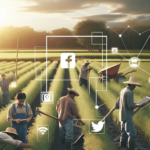Introduction to Fair Pricing in Agriculture
Did you know, to maximize profits and encourage sustainability, farmers have to understand a complex web of influences like production costs, market demand, and regional differences to determine a fair price for their products?
This multifaceted task is fundamental for the economics of agriculture.
This article will explore what constitutes a fair price, how it is calculated, and the strategies employed to achieve it. You’ll also get a glimpse into the factors influencing agricultural commodity prices, understand the cost of goods sold for a farm, and discover why farmers are typically price takers.
Let’s dive in.
Table of Contents
Understanding a Fair Price for Farmers
Defining Fair Pricing for Farmers
To determine a fair price for farmers, considering various factors such as production costs, market demand, and regional differences is fundamental.
Fair pricing helps sustain the farmer’s livelihood while ensuring consumers receive quality products.
Adjust prices based on input costs like seeds, fertilizers, and labor, alongside transportation and sales channels.
Components of a Fair Price
- Production Costs: Costs include inputs, machinery maintenance, and labor.
- Market Demand: Prices should reflect seasonal demand and supply fluctuations.
- Regional Differences: Geographical factors influence production and distribution costs.
Calculating Fair Pricing
| Factors | Considerations |
|---|---|
| Cost of Production | Total expenses incurred in producing crops or livestock. |
| Market Trends | Price trends influenced by supply, demand, and consumer preferences. |
| Distribution Costs | Expenses related to transporting products from farm to market. |
| Competitor Pricing | Prices set by other local and regional farmers for similar products. |
Strategies for Setting Fair Prices
- Stay Informed: Regularly check market prices and trends using resources like USDA’s Agricultural Marketing Service.
- Cost Analysis: Perform detailed cost analysis to understand the break-even point and profit margins.
- Direct Sales: Consider farmers’ markets or community-supported agriculture (CSA) models to eliminate middleman costs.
- Value Addition: Explore processing raw products into higher-value items to maximize profit.
Leveraging Technology for Fair Pricing
Adopt digital tools like farm management software to track expenses and monitor market trends. Utilize online platforms for buying and selling farm products directly to consumers.
Technology helps farmers remain competitive and informed about fair pricing dynamics.
Factors Driving Agricultural Commodity Prices
Supply and Demand Dynamics
In agricultural markets, commodity pricing is often governed by the fundamentals of supply and demand. Widespread temperature shifts, rainfall patterns, and natural disasters can affect crop yields, influencing supply. Similarly, changes in dietary habits and global population growth can determine demand.
It becomes vital for farmers to monitor these fundamentals actively. For instance, if a surplus of a particular crop is expected in a season, prices may drop, impacting farmers’ profitability. On the other hand, a shortfall could create a demand-supply gap, likely leading to price increases.
Global Trade and Policies
Another influential factor on agricultural commodity pricing is international trade and government policies. Trade agreements, tariffs, export/import restrictions, and subsidies can all impact the prices of agricultural commodities.
Governments sometimes implement measures to protect domestic farmers and consumers. They might subsidize agricultural inputs or provide price support to prevent farmer income from dropping below a specific level. These interventions can indirectly affect the prices that farmers get for their produce.
Financial Markets and Speculation
Financial markets can also play a significant role in the pricing of agricultural commodities. Commodity futures, which serve as financial contracts to sell or buy commodities at a predetermined price in the future, are used by farmers, commodity users, and investors alike. These futures can influence the present prices of commodities, with prices going higher or lower based on speculative demand.
Agricultural Commodity Price Indices
Tracking Commodity Prices
To better understand the real-time market prices of agricultural commodities, farmers often refer to price indices. One of the widely-used indices is the World Bank’s commodity price data, providing a comprehensive and timely resource for tracking prices of primary commodities globally.
The Role of AgTech in Commodity Pricing
Modern AgTech solutions also offer a way for farmers to stay abreast of fluctuations in commodity prices. Artificial Intelligence (AI) and machine learning algorithms can anticipate price trends based on historical data and current market developments, offering farmers insights to make informed decisions.
Despite the multitude of factors affecting agricultural commodity prices, farmers continue seeking ways to manage this volatility.
From the traditional use of futures contracts to guard against price swings, to novel approaches like predictive analytics and precision farming, a combination of solutions helps farmers achieve fair pricing and profitability for their efforts.
Understanding the Cost of Goods Sold for a Farm
What is Cost of Goods Sold (COGS)?
The Cost of Goods Sold (COGS) for a farm refers to the direct costs associated with the production of agricultural products that have been sold over a particular period. COGS is fundamental for both small and large-scale farmers as it directly impacts profitability and financial planning.
Components of COGS for a Farm
- Cost of Seeds and Fertilizers: This includes the expense of purchasing high-quality seeds and appropriate fertilizers to ensure optimal crop yield.
- Labor Costs: Wages paid to workers for planting, tending, and harvesting crops or raising livestock.
- Feed and Livestock Care: For farms that include animal husbandry, the costs include feed, veterinary care, and housing for livestock.
- Machinery and Equipment: Depreciation, maintenance, and repair costs of tractors, harvesters, and other farming equipment.
- Utilities: Expenses for water, electricity, and fuel used in the cultivation and processing of farm products.
- Pesticides and Herbicides: Chemicals used to protect crops from pests and weeds.
- Transportation: Costs incurred in moving products from the farm to the market or processing units.
- Storage: Expenses for storing products until they are sold, including renting warehouses and refrigeration costs.
Calculating the COGS
| Component | Example Costs |
|---|---|
| Seeds and Fertilizers | $10,000 |
| Labor | $15,000 |
| Feed and Livestock Care | $8,000 |
| Machinery and Equipment | $12,000 |
| Utilities | $5,000 |
| Pesticides and Herbicides | $3,000 |
| Transportation | $2,000 |
| Storage | $1,500 |
Based on the table, the total Cost of Goods Sold would be the sum of all the components: $56,500.
Tracking COGS for Better Decision Making
Monitoring COGS is essential for making informed financial and operational decisions. By tracking these costs, farmers can identify areas where they can reduce expenses without compromising quality or yield. Here are some practical strategies:
- Use Farm Management Software: Platforms like Cropio or AgriWebb can help track expenses and revenues in real time.
- Optimize Labor Costs: Implement automated systems or seasonal labor adjustments to manage cost-effectively.
- Bulk Purchasing: Buying seeds, fertilizers, and other inputs in bulk can lead to significant discounts.
- Regular Maintenance: Maintaining machinery regularly prevents costly breakdowns and prolongs equipment life.
Seasonal Variations and COGS
Agricultural production is highly seasonal, and so are the associated costs. Understanding and planning for these seasonal variations is essential for accurate COGS calculation. For example, the costs of labor and equipment maintenance may rise during planting and harvest seasons.
Farmers should account for:
- Seasonal Labor Hikes: The need for temporary workers during peak seasons.
- Weather-Dependent Inputs: Variation in irrigation and utility costs based on seasonal weather patterns.
Adjusting COGS calculations to reflect these seasonal changes ensures more accurate financial planning.
Learn more about COGS and how it affects different businesses, including farms.
How Are Farmers Price Takers?
In agricultural markets, farmers often find themselves in the position of being “price takers” rather than “price makers.” This concept is fundamental for understanding how the dynamics of supply, demand, and market forces impact the income and sustainability of farm operations.
What Does It Mean to Be a Price Taker?
A price taker is an individual or entity that has no control over the market price of the goods it sells. In a perfectly competitive market, each participant must accept the prevailing market price. Farmers, in particular, are often price takers due to several factors:
- High Competition: The agricultural sector is highly competitive with many producers growing similar crops or raising the same livestock. No single farmer can influence the market price.
- Homogeneous Products: Agricultural products, such as wheat, corn, and milk, are generally undifferentiated. This uniformity means that consumers have little reason to pay more for one farmer’s product over another’s.
- Global Markets: International trade and global supply chains mean that local prices are influenced by global production and consumption patterns. For instance, a drought in Brazil affecting coffee production can lead to price changes worldwide.
Impacts of Being a Price Taker on Farmers
Being a price taker can significantly impact farmers’ profitability and decision-making. Here are key areas affected:
- Profit Margins: Limited control over prices means farmers often have slim profit margins. They must manage costs diligently to remain profitable.
- Risk Exposure: Fluctuations in market prices can lead to volatile income streams, making financial planning and investment in new technologies or practices riskier.
- Market Pressure: Farmers are under constant pressure to adopt more efficient farming methods, reduce production costs, and scale operations to stay competitive.
Strategies for Farmers to Mitigate Price Taking
Although being a price taker presents challenges, farmers can adopt several strategies to mitigate the effects:
- Diversification: Growing a variety of crops or incorporating livestock and crop rotation can help spread risk and stabilize income.
- Value-Added Products: Processing raw materials into products like jams, cheeses, or organic produce can allow farmers to capture higher prices and differentiate their offerings.
- Direct Sales Channels: Selling directly to consumers through farmers’ markets, Community Supported Agriculture (CSA) programs, or online platforms can help eliminate middlemen and capture more value.
- Cooperatives: Joining agricultural cooperatives can give farmers more bargaining power and better access to markets and resources.
Examples of Price-Taking Situations
To illustrate, consider these scenarios where farmers are price takers:
- Commodity Crops: A Midwest corn farmer has little influence over the market prices dictated by the Chicago Board of Trade. Prices fluctuate based on supply and demand factors, with the farmer needing to adapt accordingly.
- Dairy Industry: Dairy farmers typically must sell their milk at industry-standard prices, which are influenced by national and international supply chains.
Farmers in these situations rely on market trends and forecasts to make production decisions. Staying informed about market developments can aid farmers in anticipating price changes and adjusting their strategies accordingly.
Understanding the role of farmers as price takers is fundamental to appreciating the challenges they face and the innovative solutions they employ to maintain sustainable operations. For additional insights, you can refer to this [USDA resource](https://www.usda.gov) that provides valuable information on agricultural market trends and conditions.
In Conclusion: A Delicate Dance of Prices and Profits
In essence, the world of agriculture pricing is a delicate dance involving various key concepts. These range from ‘Fair Pricing for Farmers’, where understanding production costs, market demand, and regional differences become pivotal, all the way to determining the ‘Cost of Goods Sold (COGS)’, a vital yardstick impacting profitability and financial planning.
The role of farmers as ‘Price Takers’ in the agricultural markets cannot be downplayed and their strategies to mitigate the effects of being price takers hold much importance.
Embracing technology, monitoring supply and demand dynamics, keeping abreast with global trade and policies, and understanding the impact of financial markets and speculation on pricing significantly help farmers in managing these challenges effectively.
Frequently Asked Questions – FAQs
What factors are considered in Fair Pricing for Farmers?
Key factors in fair pricing for farmers incorporate production costs, market demand, regional differences, cost of seeds and fertilizers, labor costs, machinery and equipment costs, and utilities, among others.
What strategies can farmers adopt to mitigate the effects of being Price Takers?
Farmers can adopt strategies like diversification, creating value-added products, using direct sales channels, and joining agricultural cooperatives to better manage the effects of being price takers.
Why is understanding COGS important for a farm?
Understanding the Cost of Goods Sold (COGS) is crucial for farmers as it directly affects their profitability and financial planning. It helps identify areas that can be optimized for cost reduction without compromising on quality or yield.
How do global trade and policies affect agricultural commodity pricing?
International trade and government policies can significantly influence the prices of agricultural commodities. Factors like trade agreements, tariffs, export/import restrictions, and subsidies can all impact the prices that farmers get for their produce.






